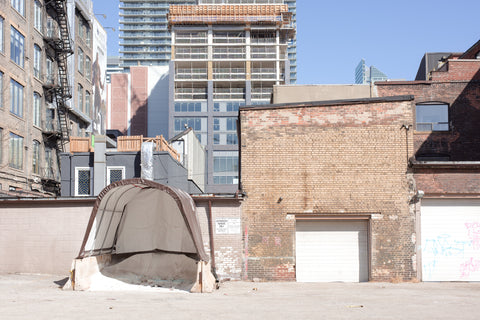PENGKUEI BEN HUANG
West Don Lands
Dimension: 60x40 inches
Year: 2021
Archival Pigment Print on Matt Paper Edition of 6"
Two Kings
The project was born out of curiosity. In the period when Toronto was placed under a strict lockdown amid the pandemic, the construction sector was listed as one of the essential industries to be allowed to continue. It seems strange that when the population influx has been disrupted by the border closure and the internal exodus, residential towers are being constructed at an accelerated pace. Compelled by this shifting landscape, I set out to explore places in the city that have increasingly become foreign.
Toronto witnessed an explosion of population growth between 2006 and 2016 according to the last census. In a span of 10 years, the city added close to 300,000 residents, surpassing any municipalities in North America during the same period. While the current growth has been contributed by increasing investments from the high-tech sector followed by years of comprehensive immigration and monetary policies at the federal level, the growth could not be realized without coherent planning to anticipate such an influx.
The Kings Regeneration Planning Initiative, known as “The Two Kings”, was a city initiative launched in 1996 to reappropriate 400 acres of land on the southern portion of downtown. It was a policy proposed by the then mayor Barbara Hall and the city’s chief planner Paul Bedford with advisories from the influential urban theorist Jane Jacobs. Under the initiative, the area would envision a thriving mixed-use community from an abandoned industrial wasteland by reconfiguring an outdated and rigid zoning by-law. The pioneer policy, though met with a degree of skepticism at the time, became a subsequent success.
Since then, Toronto’s southern downtown has experienced a dramatic transformation. Gone are empty factories and large car parks of yesteryear, with futuristic condominiums becoming new landmarks filling the space. Few structures that signify the area’s industrial past survived, but they too were reduced to a mere facade. The revitalized communities, although generating much needed urban vitality, have sparked a debate on the impact of gentrification. But the economic success of The Two Kings emboldened Toronto’s ambition to reshape neighborhoods beyond the downtown core. New towers emerged, replacing the old decadence while altering the characteristics of targeted communities.
It is within such a context I began to focus on areas where The Two Kings initiatives were implemented. It offers a glimpse of the city in transformation, for which inhabitants are growing accustomed to reluctantly. These photographs, illustrating a clash or a fusion of the modern and the past, symbolized the city's desire for a prosperous metropolis. Yet they could as well be regarded as a visual reflection on a complex relationship between the need for urban growth and the desire to preserve the characteristics of the past in our modern cities.


